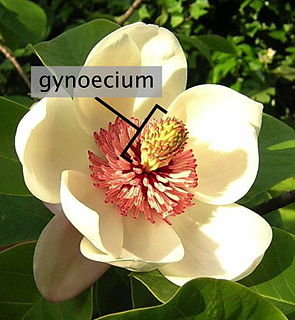
Anemone nemorosa is an early-spring flowering plant in the buttercup family Ranunculaceae, native to Europe. Common names include wood anemone, windflower, thimbleweed, and smell fox, an allusion to the musky smell of the leaves. It is a herbaceous perennial plant growing 5–15 centimetres (2–6 in) tall.

Camissonia campestris, is a flowering plant in the family Onagraceae, native to the Mojave Desert of the United States. It grows mostly on open, sandy flats, occurring from sea level to 2,000 m in the western and central part of the desert.
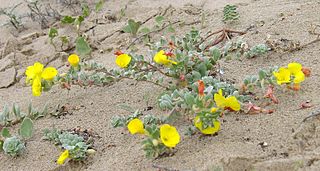
Camissoniopsis cheiranthifolia, the beach suncup or beach evening primrose, is a species of the evening primrose family and is native to open dunes and sandy soils of coastal California and Oregon.

Platystemon is a monotypic genus of flowering plants in the poppy family containing the single species Platystemon californicus, which is known by the common name creamcups. It is native to Oregon, California, Arizona, Utah and Baja California, and is found in open grasslands and sandy soils below 6,000 feet (1,800 m) elevation.

Eremothera boothii is a species of wildflower known as Booth's evening primrose. This plant is native to the western United States and northwestern Mexico where it is most abundant in arid areas such as deserts. This is an annual plant with hairy reddish-green stems and mottled foliage. The stem ends in a nodding inflorescence of many small flowers which may be white to red or yellowish, often with darker shades on the external surfaces of the four spoon-shaped petals. They have long stamens with clublike yellowish anthers. Flowers of this species tend to open at dusk rather than dawn as in many other Camissonia. The fruit is a twisted capsule one to 3 centimeters long. Plant appearances may vary across subspecies.
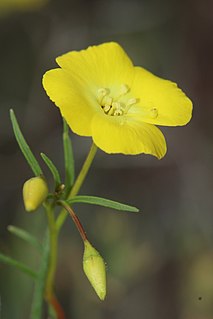
Eulobus californicus, is a species of flowering plant in the evening primrose family known by the common name California suncup. It is native to California, Arizona, and adjacent northwestern Mexico, where it grows in scrub, chaparral, and desert plant communities.

Camissoniopsis micrantha is a species of flowering plant in the evening primrose family known by the common name miniature suncup. It is endemic to California, where it grows along the coast and in the coastal mountains as far north as the San Francisco Bay Area, as well as in the Central Valley. It grows in sandy areas in a number of habitats, from beaches to inland slopes. This is a small, hairy annual herb producing a basal rosette of leaves. The stem varies in morphology, approaching half a meter in erect height or quite short and flat, with or without branching. The larger leaves are located in the basal rosette; those on the stem are narrow and shorter. The inflorescence produces bears a number of flowers with petals less than 5 millimeters long. They are bright yellow and dry to a reddish color as they close. If the inflorescence is located on an erect stem it bends the stem over with its weight. The flowers self-pollinate. The fruit is a cylindrical capsule 1 to 2 centimeters long.
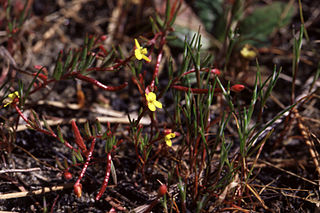
Camissonia strigulosa is a species of flowering plant in the evening primrose family known by the common name sandysoil suncup.

Camissoniopsis bistorta is a species of flowering plant in the evening primrose family known by the common names southern suncup and California suncup. It is native to southern California and Baja California, where it grows in several types of plant community along the coast and in the coastal hills and mountain ranges. This is a hairy annual or perennial herb spreading from a basal rosette with stems reaching up to 80 centimeters long. Leaves are lance-shaped to narrowly arrowhead-shaped and sometimes toothed, and 1 to 12 centimeters in length. Toward the end of the spreading stems are nodding inflorescences of flowers, each flower with four bright yellow petals dotted with red at their bases. At the center are stamens and a protruding, nearly spherical stigma. The fruit is a straight or slightly coiled capsule up to 4 centimeters long.

Chylismia cardiophylla is a species of evening primrose known by the common name heartleaf suncup. It is native to the deserts of northwestern Mexico and the southwestern United States, where it grows in sandy and rocky areas in the desert scrub. It is an annual or perennial herb approaching one meter in maximum height, taking the form of a single erect stem or a low bushy plant. The leaves are up to about 5 centimeters long and are oval or roughly heart-shaped, with rippling or dully toothed edges. The nodding inflorescence is a dense bunch of flowers, each individual cup-shaped bloom on a stout pedicel. The flowers are yellow or cream-colored with petals 3 to 12 millimeters long, and generally remain closed during the day. The fruit is a capsule 2 to 5 centimeters long.
Tetrapteron graciliflorum is a species of evening primrose known by the common name hill suncup. It is native to Oregon and California, where it grows in several habitat types, often on clay soils. It is an annual herb generally with no stem but producing an upright, nodding inflorescence. There is a cluster of narrow leaves each one to ten centimeters long. The flowers have bright yellow petals one half to two centimeters long. The fruit is a leathery capsule less than a centimeter in length with four chambers containing bumpy brown seeds.

Camissoniopsis hirtella is a species of evening primrose known by the common name Santa Cruz Island suncup. It is native to California and Baja California, where it grows on the slopes of coastal and inland hills and mountains, especially in areas that have recently burned. It is an annual herb producing a hairy stem up to about half a meter in height. Most of the leaves are located in a basal rosette at ground level and are oval in shape and a few centimeters in length. The nodding inflorescence produces flowers with sepals coated in long, glandular hairs, and bright yellow petals under a centimeter long each. The petals sometimes have red dots at their bases. The fruit is a coiling capsule up to 2 centimeters long.
Camissoniopsis intermedia is a species of evening primrose known by the common name intermediate suncup. It is native to California and Baja California, where it grows on the slopes of coastal and inland hills and mountains, especially in areas that have recently burned. It is an annual herb producing an erect, hairy stem up to about half a meter in height. Most of the leaves are located in a basal rosette at ground level and are oval to lance-shaped and up to 12 centimeters in length. The hairy, nodding inflorescence produces flowers with yellow petals just a few millimeters in length. The petals have one or two red dots at their bases. The fruit is a straight or coiling, wormlike capsule up to 2.5 centimeters long.
Camissonia lacustris is a flowering plant species commonly called grassland suncup. It is an evening primrose endemic to California, where it grows on the grasslands of the Sierra Nevada foothills. It is also known from an area in the Northern Coast Ranges in Lake County.
Camissoniopsis luciae is a species of evening primrose known by the common name Santa Lucia suncup. It is endemic to California, where it grows in the mountains of the Central Coast, mainly in chaparral habitat. It is a hairy annual herb producing an erect stem up to half a meter tall from a basal rosette. The hairy leaves have lightly toothed edges and are up to about 5 centimeters long. The nodding inflorescence produces flowers with yellow petals a few millimeters long with red markings near the bases. The fruit is a straight or coiling capsule.
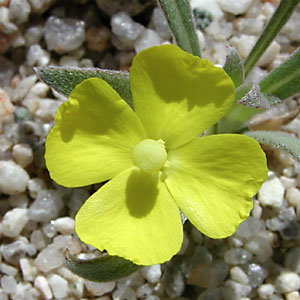
Camissoniopsis pallida is a low growing, yellow-flowered annual plant in the evening primrose (Onagraceae) family. It is known by the common names pale primrose or pale yellow suncup. It is native to the desert and scrub habitat of the region where Arizona, California, and Nevada meet. It is a roughly hairy annual herb growing in a low patch on the ground, sometimes producing an erect stem from the basal rosette. The herbage is gray-green to reddish green. The leaves are lance-shaped and up to 3 centimeters long. The nodding inflorescence produces flowers with yellow petals 2 to 13 millimeters long, each with small red markings near the bases. The fruit is a straight to tightly coiled capsule.

Camissonia parvula is a species of evening primrose known by the common name Lewis River suncup. It is native to the Great Basin of the United States. It grows in sagebrush, woodland, and other Great Basin habitat. It is a slender annual herb producing a wiry erect stem 15 to 30 centimeters in maximum height. The leaves are linear in shape and 1 to 3 centimeters long. They are located along the stem as there is no basal rosette. The nodding inflorescence produces flowers with yellow petals only 2 or 3 millimeters long. The fruit is a capsule 2 to 3 centimeters long, swollen with seeds, and sometimes coiling.
Chylismiella pterosperma is a species of evening primrose known by the common name wingfruit suncup and is the only species in the monotypic genus Chylismiella. It is native to the western United States, where it grows in several habitat types, including sagebrush. It is a slender annual herb producing an erect stem up to about 14 centimeters in height. The leaves are up to 3 centimeters long and densely coated in bristly hairs. The nodding inflorescence produces flowers with white petals each less than 3 millimeters long. They are sometimes yellow near the bases and fade to a purple color as they wither. The fruit is a straight capsule about 1 to 3 centimeters long with a thick wing down the middle.

Camissonia pubens is a species of evening primrose known by the common name hairy suncup. It is native to the desert and steppe of western Nevada and eastern California. It is an annual herb covered in glandular hairs generally made up of one or more erect, slender stems up to a third of a meter tall. The leaves are up to about 4 centimeters long and are lance-shaped with wavy, toothed edges. The nodding inflorescence produces flowers with yellow petals each a few millimeters long and sometimes dotted with red near the bases. The fruit is a straight or coiling capsule up to 5 centimeters long.
Camissonia pusilla is a species of evening primrose known by the common name little wiry suncup. It is native to the western United States from California to Idaho, where it grows in sagebrush and other habitat. It is a petite, hairy, glandular annual herb producing very slender erect stems up to about 22 centimeters in maximum height. The leaves linear with toothed edges and 1 to 3 centimeters long. The nodding inflorescence produces flowers with yellow petals 2 or 3 millimeters long and usually spotted with red near the bases. The fruit is a straight or coiling capsule up to 3 centimeters long.



